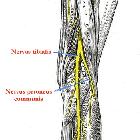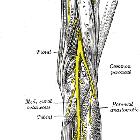Nervus ischiadicus






The sciatic nerve arises from the sacral plexus from the roots of L4-S3 and runs through the buttock and down the lower limb. It is the longest and widest single nerve in the body.
Summary
- origin: sacral plexus (L4-S3)
- course: exits the pelvis through the greater sciatic foramen to enter the leg between ischial tuberosity and femoral greater trochanter, then courses inferiorly through the posterior compartment of the thigh
- major branches
- tibial nerve (L4-S3)
- common peroneal nerve (L4-S2)
- motor supply: see motor supply of the sciatic nerve
- sensory supply: no direct sensory function. Indirect sensory supply to the foot (plantar surface: tibial nerve, dorsal surface: common peroneal nerve) and the leg (except its inner side, which is supplied by the saphenous nerve)
Gross anatomy
Origin
The nerve forms from the anterior divisions of the L4-S3 roots (which form the tibial component) and posterior divisions of the L4-S2 roots (which form the common peroneal component) of the sacral plexus.
Course
The sciatic nerve enters the lower limb by exiting the pelvis through the greater sciatic foramen, below the piriformis muscle and above the superior gemellus muscle.
It descends midway in between the greater trochanter of the femur and the tuberosity of the ischium and in the posterior compartment of the thigh to the apex of the popliteal fossa, where it divides into two large terminal branches:
Relations
- anteriorly
- upper part: posterior surface of the ischium, nerve to quadratus femoris, obturator internus, the gemelli
- lower part: adductor magnus
- posteriorly
- upper part: gluteus maximus
- lower part: long head of biceps femoris (crosses obliquely)
In the upper part of its course, it is accompanied by the posterior femoral cutaneous nerve and the inferior gluteal artery, and is covered by the gluteus maximus muscle.
Branches
The nerve gives off articular and muscular branches before dividing into two terminal branches - the tibial nerve and the common peroneal nerve.
Articular branches
The articular branches arise from the upper part of the nerve and supply the hip joint, perforating the posterior part of its capsule; they are sometimes derived from the sacral plexus.
Muscular branches
The sciatic nerve supplies the following muscles:
- biceps femoris: supply to short head arises from the common peroneal part, supply to long head arises from the tibial part
- semitendinosus: arises from the tibial part
- semimembranosus: arises from the tibial part
- adductor magnus: arises from the tibial part
Variant anatomy
The division of the sciatic nerve into the common peroneal and tibial nerves may take place at any point between the sacral plexus and the lower third of the thigh. When it occurs at the sacral plexus, the common peroneal nerve usually pierces the piriformis muscle.
A range of other variants exist based on the relationship to the piriformis muscle.
- Division in the pelvis with
- Common peroneal nerve piercing piriformis muscle and tibial nerve exiting below (mentioned above)
- Common peroneal nerve traveling above piriformis muscle and tibial nerve below
- Common peroneal nerve traveling above piriformis muscle and tibial nerve piercing pirformis muscle
- Both common peroneal nerve and tibial nerve traveling below piriformis muscle separately
- Sciatic nerve courses over piriformis muscle
- Sciatic nerve pierces piriformis muscle
Radiographic features
Ultrasound
- appears as a hypoechoic round structure, situated deep to piriformis and gluteus maximus muscles
Related pathology
Pain and functional symptoms may be caused by a compression or irritation of the sciatic nerve. This may be caused by:
- spinal disc herniation
- degenerative disc disease
- spinal stenosis
- spondylolisthesis
- piriformis syndrome
Siehe auch:
- Nervus fibularis communis
- Foramen ischiadicum majus
- Becken
- Musculus piriformis
- Nervus tibialis
- Piriformis-Syndrom
- sciatic neuropathia
und weiter:

 Assoziationen und Differentialdiagnosen zu Nervus ischiadicus:
Assoziationen und Differentialdiagnosen zu Nervus ischiadicus:




